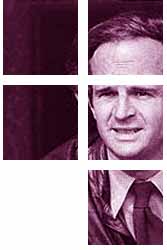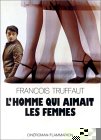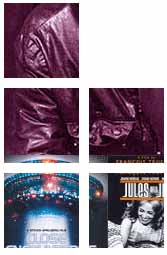





|
ENGLISH BOOKS click on book to purchase
|
|
 |
Hitchcock
Any book-length interview with Alfred Hitchcock is valuable, but considering that this volume's interlocutor is François Truffaut, the conversation is remarkable indeed. Here is a rare opportunity to eavesdrop on two cinematic masters from very different backgrounds as they cover each of Hitch's films in succession. Though this book was initially published in 1967 when Hitchcock was still active, Truffaut later prepared a revised edition that covered the final stages of his career. It's difficult to think of a more informative or entertaining introduction to Hitchcock's art, interests, and peculiar sense of humor. The book is a storehouse of insight and witticism, including the master's impressions of a classic like Rear Window ("I was feeling very creative at the time, the batteries were well charged"), his technical insight into Psycho's shower scene ("the knife never touched the body; it was all done in the [editing]"), and his ruminations on flops such as Under Capricorn ("If I were to make another picture in Australia today, I'd have a policeman hop into the pocket of a kangaroo and yell 'Follow that car!'"). This is one of the most delightful film books in print. --Raphael Shargel
|
 |
The
Films in My Life
A film critic and director, Francois Truffaut, brings the reader into an almost literary expositon on films and how they affect us. He takes film beyond its bounds by noting the joys and sorrows directors have put into their creations. Truffaut, as a great director himself, discusses directors and actors like Hitchcock, Renoir, Bergman, Kazin, Welles, Wilder, and many others. What impressed me about the book was the compassion Truffaut has for film making. He brings out the nuances that I failed to notice in great films. For instance, in his discussion of Citizen Kane, he brings out the parallelism between Charles Foster Kane's mother and his love for Susan Alexander by saying Alexander was areplacemnent for his separated mother. And of course rosebud and the snow dome create the crux for such parallels to show uo. In his review for Kane, he brings out such nuances that only a well-carved critic and director could do. Those out there who enjoy film and all its! ! complexities will enjoy this book. A Frenchman discovers what made such films great in so many people's eyes: Rear Window, 8 1/2, The Seven Year Itch, and many other great films. I love Truffaut, so reading what he likes and dislikes was a sheer pleasure - sumptuous at times!
|
 |
The mass movie audience knows him best as the sweet French scientist in Close Encounters of the Third Kind, but François Truffaut (1932-1984) made his first thunderous impact on world cinema as "that young thug of journalism." In the 1950s, as this culturally savvy biography by two French film journalists reminds us, Truffaut and a group of like-minded friends at the legendary Cahiers du Cinéma blasted traditional French film as too literary and polished. They proclaimed the birth of rougher, more personal moviemaking by "auteurs" (directors who wrote their own scripts) who were as intoxicated by the medium's possibilities as by the classic Hollywood movies these Young Turks adored. Truffaut practiced what he preached in early films like The Four Hundred Blows and Jules and Jim, which electrified a new generation of American directors who came of age in the 1960s. His private life was just as unconventional: though divorced from his first wife in 1965, they remained business associates through his many affairs with actresses (to whom he was also chronically unfaithful), and he even moved back in with her for a while when the brain tumor that ultimately killed him made it impossible to function alone. His biographers convey all this turbulent material with Gallic lucidity and toughness, seeing no need to make their subject conventionally lovable by softening his sharp edges. --Wendy Smith
|
 |
Orson Welles : A Critical View
|
 |
Francois
Truffaut
Vue d'ensemble de l'oeuvre du cinéaste français. Genèse et analyse de ses principaux films. L'auteur aborde le cinéma de Truffaut en regardant de plus près la façon dont le réalisateur travaille sur les différentes versions de ses scénarios.
|
 |
The
Early Film Criticism of Francois Truffaut
\The 60 film reviews in this volume, now published in English for the first time, mark a delightful and significant addition to the great French filmmaker's canon. The astute commentary of Dixon, director of film studies at the University of Nebraska, places the Truffaut writings in both historical and biographical contexts. The collection is built around several themes, most prominently Truffaut's concern with the American B-movie and with favorite filmmakers like Renoir, Lang, Cukor and Hitchcock (whom he praises particularly effusively). Likewise, he is warm in his praise of Cukor's collaboration with Garson Kanin: ``They reward American cinema every year with a masterpiece.'' Although his films bespeak a warm and fuzzy liberal humanism, as a film critic Truffaut had a reputation as a devastating hatchet man. This volume includes a savage and funny pan of Giant and more guardedly negative assessments of John Huston, of whom Truffaut asks, ``Will he always be no more than an amateur?'' Dixon argues that what makes these early writings important is Truffaut's dual role as a great filmmaker and as one of the first critics to take American genre films seriously. But what makes the book enjoyable is Truffaut's often witty and provocative writing.
|
 |
Jean
Renoir
François Truffaut's cool, creamy-smooth melodrama of a
|
 |
Cutting
the Body : Representing Woman in Baudelaire's Poetry, Truffaut's Cinema,
and Freud's Psychoanalysis (The Body, in Theory: Histories of cultura
|
 |
A
Passion for Films : Henri Langlois & the Cinematheque Francaise
"Richard Roud has brought to life a man as picturesque and as contradictory as a Dickens character . . . a man who was both unassuming and extravagant, a fabulous man, an obsessed man, a man animated by an idée fixe, a haunted man."-François Truffaut When Henri Langlois began collecting prints of films in the 1920s, most people-even many in the film industry-thought of movies as a cheap and disposable form of entertainment. Langlois recognized them as a priceless form of art and worthy of preservation. In 1935, he founded the Cinémathèque Française, the legendary film library and screening room in Paris which Jean Renoir described as "the church for movies" and Bernardo Bertolucci called "the best school of cinema in the world." Indeed, some of the world's most influential filmmakers-including Godard, Resnais, Truffaut, Rivette, and Wenders-learned their craft there by watching the classic films Langlois devoted his life to saving from destruction and obscurity. As Richard Roud reveals in this "affectionate, intriguing biography" (Times Literary Supplement), Langlois was a brilliant and temperamental man who could be, by turns, charming and maddening. By the time of his death in 1977, Langlois's genius for rediscovering the cinema of the past had inspired a great and abiding love of cinema in a generation of filmgoers, leaving behind a legacy director Nicholas Ray considered "perhaps the most important individual effort ever accomplished in the history of the cinema." "A Passion for Films is a perfect title for Richard Roud's loving biography of Langlois . . . His book is also a personal memoir and a brief history of film archives and archivists. Most important, A Passion for Films provides an account of how Langlois virtually single-handedly created what we call today a film culture."-Dan Isaac, New York Times Book Review "Part scholarly biography and part personal memoir . . . this is a good place to start learning about one of film's most charismatic figures."-Library Journal "The greatest value of this book is the clear outline it gives of Langlois's career and the history of film archives . . . Langlois was a flawed man and a curator who aired his films a little too boldly sometimes. But as Roud argues, he was a key instigator of the last great burst of creative energy in filmmaking: the New Wave. America has so poor a record in preserving its own films that the story of Langlois's efforts makes a great lesson."-David Thompson, New Republic "Richard Roud has written a truly great and important book that cannot fail to be considered a major contribution to film history."-Marcel Ophuls, American Film Richard Roud was the director of the London Film Festival from 1960 to 1969 and of the New York Film Festival from its inauguration in 1963 until 1987. He is also the author of three books on individual directors (Max Ophuls, Jean-Luc Godard, and Jean-Marie Straub) and editor of the two-volume Cinema: A Critical Dictionary. He died in Nimes, France, in 1989.
|
 |
The
Last Metro : Francois Truffaut
|
 |
François Truffaut's 1957 short "Les Mistons" (roughly translated to "The Brats") is an early testament to Truffaut's affinity with kids and his first exploration of impossible love. Five boys palling around one summer fall for a teen beauty, but as the narrator (one of the five) describes, "Too young to love Bernadette, we decided to hate her--and torment her." These adolescent boys are neither cute nor innocent, but Truffaut sympathizes with the frustration born of budding hormones and sexual mystery. In 1962, he revisited similar territory in the sketch "Antoine and Collette." The second film to feature alter ego Antoine Doinel (Jean-Pierre Léaud), it was originally made for the omnibus film Love at Twenty but has outlived its companion shorts. As romantic and gently ironic as The 400 Blows is harsh and haunting, this modest 20-minute lark finds a teenage Antoine pursuing the lovely, lithe 20-year-old Colette (Marie-France Pisier) like a lovesick puppy dog. The comic sweetness of this episode sets the tone for all future Doinel films, and Léaud, who matured into the poster boy for the French new wave, displays the lanky charm and self-effacing egotism that propelled him through some of the greatest films of the next two decades.
|
 |
L'homme
qui aimait les femmes
François Truffaut's cool, creamy-smooth melodrama of a doomed affair sets the lush romanticism of exciting indiscretion in a world where sudden stabs of ominous music hint at a tragedy in the making. Jean Desailly is a famous literary critic and publisher who becomes entranced with the lithe, strikingly beautiful flight attendant (Françoise Dorleac) who keeps crisscrossing his path while he's away on a speaking engagement. He's middle-aged, successful, and seemingly happily married with a wife and daughter, but he plunges ahead with an affair, careful to avoid friends and familiar places. The Soft Skin is not really a thriller, but Truffaut invests it with Hitchcockian echoes of guilt and fear of discovery, and he meticulously plots scenes with the precision of a heist film. Pulling back the veneer of chic elegance and attractive confidence, Desailly emerges not so much sordid as vain and pathetic, and his wife (Nelly Benedetti) comes into her own with her heartbreaking discovery of his lies. At once angry, hurt, and threatened, she grasps at reconciliation while sabotaging her own efforts with frustrated attacks. It's an unusual film with sudden changes in tone that do little to prepare the viewer for the dark climax: the tragic side of Truffaut's fascination with philandering men that runs throughout his career. Fans will recognize the scene with the kitten who licks off the plate set out for room service--he re-created it in Day for Night.
|
 |
Directing
This latest entry in the scholarly "Filmmakers" series is a fascinating look inside the minds of some of the world's most prominent film directors. The book is essentially a compilation of 43 answers to a questionnaire developed by Garnett, the veteran director who shot the original The Postman Always Rings Twice. Respondants are both famous and obscure, from all eras and nationalities. Questions range from mundane ("What was your first film job?") to perceptive inquiries about personal philosophies of filmmaking, preferences in acting styles, and methods of working with crew members. Most of the responses were candid and make for interesting reading. While some of the information is outdated (Garnett died in 1977), most of the questions were so thoughtfully composed that the information garnered from them is timeless in nature. Recommended for large film collections.
|


